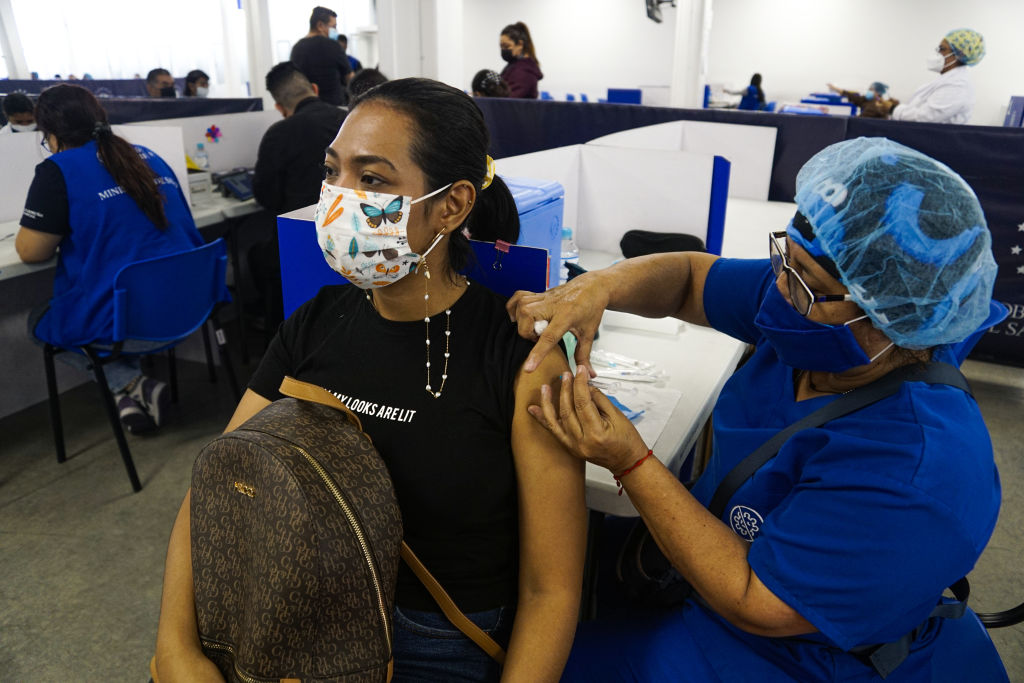Over the past year, the headlines have been dominated by alarming events: the Russian invasion of Ukraine, high inflation, supply chain shortages, and the threat of food insecurity for many nations. But 2022 was also a year of milestones toward a better future, scientific breakthroughs, and stories of hope. Here’s a look at 10 stories of human progress from the last 12 months.
1. We found out that civilization reached peak agricultural land
For nearly all of human history, producing more food required more land. But starting in the early 1900s, and continuing through the next 100 years, four powerful forces—synthetic nitrogen fertilizer, synthetic pesticides, hydrocarbon-powered mechanization, and improved genetic selection—allowed humanity to produce more food from less land. Between 1900 and 2000, agricultural land—that is, the sum of cropland and pastoral land used for grazing livestock— increased dramatically and consistently year after year.
But the latest data released in 2022 suggest that while land use for crops is still increasing, total agricultural land use appears to have peaked in the year 2000, and is now in decline. Peak agricultural land use has been driven in large part by changing the way we feed the animals we eat, shifting from grazing livestock to feeding them crops we’ve grown. The change has helped reduce the amount of land that must be converted from wilderness to pasture, which has, in turn, reduced the pressure on wildlife habitat. Progress forward is, however, not progress completed, and to continue to reduce pasture land allocation and turn the tide toward peak cropland, we must continue to improve crop yields.
2. We deployed a malaria vaccine for the first time
Between the years 2000 and 2020, global malaria deaths declined by roughly 30%; however, in 2021, there were still an estimated 247 million cases and 619,000 related deaths. The hard-won progress thus far has been driven in large part by the expanding use of insecticide-treated bed nets and antimalarial drugs. The most powerful tool in the war against malaria, a safe and effective malaria vaccine, has remained out of reach.
But this year, for the first time, the World Health Organization recommended the use of a malaria vaccine: the RTS,S/AS01 Mosquirix shot, which the WHO said should be deployed to protect children living in regions with moderate to high transmission. By April 2022, more than 1 million children in Africa had received the world’s first malaria vaccine. The WHO estimates that the shot could save the lives of roughly 40,000 to 80,000 such children annually.
The World Health Organization backed the widespread rollout of the Mosquirix vaccine after successful pilot programs in Kenya, Ghana, and Malawi.
Patrick Meinhardt—Getty Images
In addition, another malaria vaccine, the R21/Matrix-M developed by Adrian Hill and the University of Oxford, also continued to show promise. According to a study published in The Lancet in early December, the vaccine provided 80% protection against the disease in human trials. If approved, the plan is for the R21 malaria vaccine to go into production with the Serum Institute of India, with a target of 200 million doses annually, and may be sold at less than half the price of the RTS,S malaria vaccine.
3. The James Webb telescope brought the universe into focus
Through the end of 2021 and the beginning of 2022, the James Webb Space Telescope had a successful launch, essentially flawless deployment and calibration, and began returning its first images. The next-generation telescope took nearly 26 years and $10 billion to make happen. But it appears the gamble is going to pay off, as Webb brings into focus the way galaxies looked just a few hundred million years after the formation of the universe.
The first images from Webb, released in July of 2022, captured the imagination of the world, instilling a sense of both wonder at the magnitude and beauty of space, and also our small and seemingly insignificant place within the greater universe.

Anyone home? One of the first images from NASA’s James Webb Space Telescope, showing galaxy cluster SMACS 0723.
NASA, ESA, CSA, STScI, Webb ERO
The focus in 2023 will turn to the telescope’s primary missions: studying the early galaxies of the universe, observing star formation, and observing the chemical properties of planetary systems, inclusive of the solar system in which we reside. This year there were hundreds of ways that Webb could have gone wrong, and only one way for the mission to go right. Against all odds, Webb performed flawlessly.
Read more: TIME’s Innovator of the Year for 2022: Gregory Robinson and the James Webb Telescope Team
4. Wild mammals rebounded in Europe
Across Europe, many wild animals are making a comeback, returning to the region’s oceans, forests, and rivers. A reduction in habitat loss and conservation, along with reintroduction programs, offer hope for a future where many native species to the region can once again flourish.
For much of the 20th century, hunting and habitat loss reduced large animal populations throughout the European continent. But over the last 50 years, many species have made an incredible comeback, with stable and self-perpetuating populations of large animals, from whales to bison, rebounding.
At least 19 species had an average relative change in abundance greater than 100%, while at the top end of improvements, European bison and Eurasian beaver populations grew by an astonishing 16,626% and 16,705%, respectively.

A European bison in the German state of Brandenburg, on Jan. 4, 2021. For the past decade, bison have been living largely undisturbed by humans in a protected wilderness zone in this part of Germany.
Ingolf König-Jablonski—Picture Alliance/Getty Images
5. Farmers in the Philippines harvested the first large-scale genetically engineered “golden” rice crop
One of the best stories of progress this year unfolded quietly in 17 rice fields in the Philippines this October. For the first time in world history, farmers in the Philippines harvested golden rice on a large scale—some 74 tons that had been cultivated over the previous year. That’s relatively insignificant when compared to the annual production of conventional rice for the country, a little over 13 million tons in 2022; it is, however, a milestone for genetically engineered rice. While golden rice has been around for decades, this is the first time it has been made legally available.
Golden rice is a powerful tool in the fight against vitamin A deficiency, a condition that claims the eyesight and lives of hundreds of thousands of children annually. In 2009 the WHO estimated that “250,000–500,000 children who are vitamin A-deficient become blind every year, and half of them die within 12 months of losing their sight.”
Often, this condition affects children in low- and middle-income regions with a high dependency on standard rice, which lacks vitamin A. Golden rice is a version of the staple grain genetically engineered to produce vitamin A, and in theory, could reduce or eliminate vitamin A deficiencies without requiring a major change in dietary habits.
6. Guinea worm disease reached near-eradication levels
In 1989, there were 892,055 cases of Guinea worm disease, a dreadful and debilitating waterborne parasitic infection historically endemic to Asia, the Middle East, and Africa. In 2022 there were just 15 cases globally—a decline of 99.998%.
This astonishing decline in infection rates was driven not by a new vaccine or breakthrough technology, but through community education programs, effective isolation of infected persons from water sources, expanding access to improved and treated water sources, and basic water filtration. Thanks to these largely low-tech mitigations there is now hope that it may be possible, perhaps within the next few years, to declare the disease truly eradicated,
7. India developed its first cervical cancer vaccine
The Serum Institute of India, the world’s largest vaccine manufacturer, announced the development of India’s first domestically developed and manufactured cervical cancer vaccine—but it’s the price that is the true breakthrough. The newly-developed vaccine will provide broad protection against the human papilloma virus (HPV), types 16 and 18, which are responsible for at least 70% of cervical cancers, as well as types 6 and 11.
While there are already two highly effective HPV vaccines available in India—Gardasil, from Merck, and Cervarix, from GlaxoSmithKline—they are both prohibitively expensive for many low-income families in India, with each dose costing Rs 2,800 (about $34) and Rs 3,299 (about $40), respectively. The price point for the new domestically-manufactured HPV vaccine is expected to be between 200 rupees and 400 rupees ($2.42-$4.85), ultimately helping more girls across India access the potentially life-saving shot. The Serum Institute is targeting to produce approximately 200 million doses over the coming two years.
8. Lab-grown meat got the green light from the U.S. FDA
Lab-grown meat has been on the horizon for over a decade, with the world’s first lab-grown burger eaten in 2013. In 2022, the technology had a milestone breakthrough, when California-based Upside Foods’ meat cultivated directly from chicken cells was given a green light from the U.S. Food and Drug Administration. The FDA basically says Upside’s cultivated chicken is safe for human consumption; the next step is to get approval from the U.S. Department of Agriculture. After that, it would be the first lab-grown meat to be sold in the U.S.

A dish made with Upside Foods’ lab-grown chicken product
Rozette Rago for TIME
The technology, while still in its infancy, could help transform how we grow and consume meat, providing a sustainable alternative to the modern factory farm. If developers can effectively scale and market lab-grown meat effectively, it could help to offset the high inefficiency losses in using living animals to turn energy into delicious protein, reducing resource consumption and credulity.
Read More: Exclusive: We Tasted The World’s First Cultivated Steak, No Cows Required
9. The SARS-COV-2 vaccine saved millions of lives
In light of the hardships experienced by billions of people globally, you would be forgiven for overlooking the silver lining that was the rapid research, development, manufacturing, and deployment of the four primary COVID-19 vaccines. A study published in June in The Lancet concluded that SARS-COV2 vaccination had already prevented between 14-20 million COVID-19 related deaths across 185 countries globally.

A health worker administering a COVID-19 vaccine booster shot on March 22, 2022, in San Salvador, El Salvador.
Emerson Flores—APHOTOGRAFIA/Getty Images
The Commonwealth Fund, a private foundation, estimates that the administration of the roughly 655 million doses covering 80% of the U.S. population has prevented more than 18 million hospitalizations and 3 million deaths. The vaccine deployment saved an estimated $1 trillion in medical costs, to say nothing of the social and emotional devastation it helped avoid.
10. CRISPR for cancer had a major breakthrough
This year has been replete with news of advancement in medical and agricultural applications for the genetic engineering tool CRISPR. Among the most powerful stories about CRISPR was its breakthrough effect in the treatment of a 13-year-old girl suffering from aggressive leukemia that was unresponsive to conventional treatment. The teenager had her immune cells genetically altered via CRISPR to seek out and destroy cancer; she now has no detectable cancer within her body.
While it may be too early to hail the new treatment as a readily deployable cure, it’s unquestionably a major breakthrough, possibly a watershed moment in the history of how humanity treats cancer. Doctors and researchers are now working toward engaging another 10 adolescent patients for further trials of the treatment.
The breakthrough was part of the larger story of progress in the use of CRISPR for the treatment of cancer, with research advancing on a number of fronts, including most prominently a promising personalized T cell modification which would allow for the body’s own immune system to fight solid cancers, and with the FDA lifting its ban on CRISPR base editing for cancer treatment.
More Must-Reads From TIME



